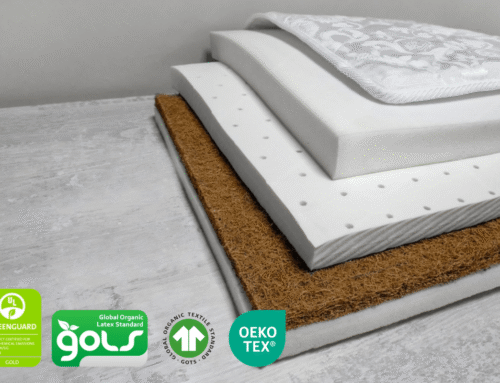Shopping for a mattress can feel overwhelming—foam here, coils there, maybe even latex. It’s easy to get lost in the options, but understanding what are mattresses made of can make all the difference. The materials impact everything from comfort to support and durability. Ever wondered who invented the mattress? While it’s evolved a lot since ancient times, today’s beds are crafted with innovation and science to support our sleep like never before.
Knowing how to choose a mattress that suits your sleep style—whether you’re a side sleeper, back sleeper, or somewhere in between—can be a game changer. Materials like memory foam contour to your body, while innersprings offer a bouncier, more traditional feel. And don’t forget: how often you should replace a mattress depends on what it’s made of, but generally every 7–10 years is a safe bet.
Let’s break down the most common types to help you find your perfect match.
Key Takeaways
- Memory Foam: Contours to your body, relieving pressure points. Ideal for side sleepers and those with joint pain.
- Latex: Offers a responsive, bouncy feel with natural cooling properties. Great for eco-conscious individuals and those seeking durability.
- Innerspring: Provides traditional bounce and strong edge support. Suitable for back sleepers and those preferring a firmer feel.
- Hybrid: Combines foam and coils for balanced comfort and support. Versatile choice for various sleep positions.

Memory Foam
Memory foam is a fan favorite for a reason. It’s soft, supportive, and molds to your body like a gentle hug. Originally developed by NASA, it’s made from polyurethane and reacts to your body heat and weight to create a personalized, cradling feel. It’s especially great for side sleepers or anyone dealing with aches and pressure points.
If you’ve ever wondered how your mattress seems to know exactly where your shoulder or hip lands, it all comes down to bed anatomy. The layers inside work together to provide comfort and support. Memory foam excels in pressure relief, but it can sometimes trap heat. If you’re a hot sleeper, keep an eye out for cooling gel or open-cell designs that help promote airflow.
All in all, memory foam offers a cozy, contouring experience that can really level up your sleep. Just be sure to pick the right version for your needs.
Latex
Latex mattresses are a great choice if you’re after something natural, supportive, and long-lasting. Made from rubber tree sap—though there are synthetic options too—latex is breathable, bouncy, and super durable. Unlike memory foam, which hugs your body, latex has a more responsive feel. You’ll feel like you’re resting on the mattress rather than sinking into it.
It’s especially ideal for people with allergies, since natural latex is hypoallergenic, and it’s a win for those wanting a more eco-conscious sleep setup. That said, latex mattresses can be a bit pricier, so it helps to know how much you should spend on a mattress before shopping. The good news? You don’t always have to pay full price. Knowing the best time to buy a mattress—like during major holiday sales—can help you score a quality latex bed without breaking the bank.
In short, latex offers comfort, bounce, and peace of mind.
Innerspring Coils
Innerspring mattresses are the classic choice. If you grew up bouncing on a bed, it was probably one of these. They use a network of metal coils to provide support, giving them a firmer, more traditional feel. One big perk? They’re generally more breathable than foam mattresses, which is great if you tend to sleep hot.
There are a few different types of coils used in these beds: Bonnell, offset, continuous, and pocketed coils. Each has its own pros, but pocketed coils are especially popular these days because they help with motion isolation. That means if your partner tosses and turns, you’re less likely to feel it.
If you’re looking for something durable with solid support and a bit of bounce, innerspring might be your style. They’re a no-fuss, dependable option, especially for folks who prefer a firmer mattress and a cooler night’s sleep.
Hybrid Designs
Hybrid mattresses are like the best of both worlds wrapped into one comfy package. They combine the solid support of innerspring coils with the plush comfort of foam or latex layers on top. If you want a mattress that gives you both bounce and a little hug, hybrids strike that perfect balance.
They’re especially great for people who deal with back pain, offering the support your spine needs without sacrificing softness. Plus, because of the coil system, hybrids tend to breathe better than all-foam beds, which can really help if you sleep hot and need some airflow to stay cool through the night.
Whether you’re a back sleeper needing firmness or a side sleeper craving cushioning, a hybrid can adapt to your needs. They’re a solid middle-ground choice if you’re not quite sure what to go for, offering comfort, support, and versatility all in one sleep-friendly design.
Polyfoam
Polyfoam, short for polyurethane foam, is one of the most common materials you’ll find in mattresses today. It’s lightweight, affordable, and super versatile, which is why it often shows up in everything from budget beds to the support layers of more expensive models. While it doesn’t have the same body-hugging feel as memory foam, it still offers a decent level of comfort and support.
Basic polyfoam is great for keeping costs down, making it a solid pick if you’re shopping on a tight budget. Just keep in mind that not all polyfoam is created equal. Higher-density versions are more durable and supportive, so they’re worth considering if you want your mattress to last a little longer.
If you’re looking for a no-fuss, affordable option that gets the job done, polyfoam might be your match, especially if you pair it with the right construction and comfort layers for your sleep style.

Gel Infused Foam
Gel-infused foam is a smart twist on traditional memory foam, designed with hot sleepers in mind. Basically, it’s memory foam with cooling gel added in to help regulate temperature. The idea is to draw heat away from your body while you sleep, so you don’t wake up in a sweat.
In terms of feel, gel foam is pretty similar to regular memory foam. It still contours to your body and offers that cozy, cradled sensation. But the cooling gel can make a real difference if you tend to run warm at night. Some mattresses mix the gel evenly throughout the foam, while others use gel beads or layers strategically placed to target heat buildup.
If you love the comfort of memory foam but don’t love the heat that sometimes comes with it, gel-infused foam is a solid upgrade. It’s all about staying cool without sacrificing that soft, supportive feel people love.
Natural and Organic Materials
If you’re looking for a more eco-friendly sleep setup, natural and organic materials are a great place to start. These mattresses often use things like natural latex, organic cotton, wool, bamboo, and even coconut fiber. Not only are they better for the environment, but they also tend to be more breathable. Great news if you’re a hot sleeper or sensitive to synthetic materials.
One of the biggest perks? Fewer chemicals. If you’re someone who’s sensitive to odors, has allergies, or just wants a cleaner, healthier sleeping space, natural materials can make a big difference. Plus, wool and cotton can help with temperature regulation, keeping you comfy year-round.
While organic mattresses can be more expensive upfront, many people find the long-term benefits—like durability, reduced allergens, and peace of mind—totally worth it. If sustainability and sleep quality matter to you, going natural might be the perfect fit for your bedtime routine.
Microcoils
Microcoils, sometimes called mini coils, are tiny springs tucked into the comfort layers of hybrid or high-end mattresses. They might be small, but they pack a punch, adding a nice bit of bounce and airflow without compromising on softness or pressure relief.
You’ll often find microcoils layered with foam or latex, creating a plush-yet-supportive feel that adapts to your body without sinking too much. It’s a great combo for anyone who wants a cozy surface that still feels responsive and breathable.
Another bonus? Microcoils can actually help extend the life of your mattress. By reducing how much the foam compresses over time, they help your bed stay comfortable and supportive for longer.
If you’re looking for that sweet spot between soft comfort and long-lasting support, mattresses with microcoils are definitely worth checking out. They’re a subtle upgrade that can make a big difference in how your bed feels night after night.

Quilting and Ticking Fabrics
Quilting and ticking fabrics might not get as much attention as coils or foam, but they play a big role in how your mattress feels and breathes. These are the top layers you see and touch—the fabric and stitching that cover everything inside. Common materials include polyester, cotton, wool, and bamboo, each bringing something different to the table.
Some mattresses use extra padding in the quilting to add a soft, cushiony feel right on top. Natural fabrics like cotton and wool are great at wicking away moisture and helping you stay cool throughout the night. Bamboo is another breathable option that’s also eco-friendly. On the other hand, synthetic fabrics like polyester tend to be more durable and stain-resistant, which can be a plus if you want something that lasts.
So while it might seem like just the “outer shell,” the ticking and quilting can seriously boost comfort and help with temperature control.
How to Choose the Right Mattress Materials
Choosing the right mattress materials starts with understanding your sleep style. Side sleepers typically need softer foam that cushions pressure points, while back and stomach sleepers benefit from firmer options like latex or innerspring coils for proper support.
Budget matters too. Foam and polyfoam are more affordable upfront, but materials like latex and hybrids tend to be more durable, which can save you money in the long run. If you’ve been waking up sore or tossing and turning, those could be signs you need a new mattress. It’s also good to know how often you should replace your mattress—usually every 7 to 10 years, depending on quality.
Got allergies? Look for hypoallergenic or organic materials. Sleep hot? Go for breathable options like coils, gel-infused foams, or natural fabrics like cotton or bamboo. And if supporting local matters to you, keep an eye out for mattresses made in the USA for both quality and peace of mind.
Frequently Asked Questions
One Comment
Comments are closed.








[…] Understand the importance of mattress materials. […]